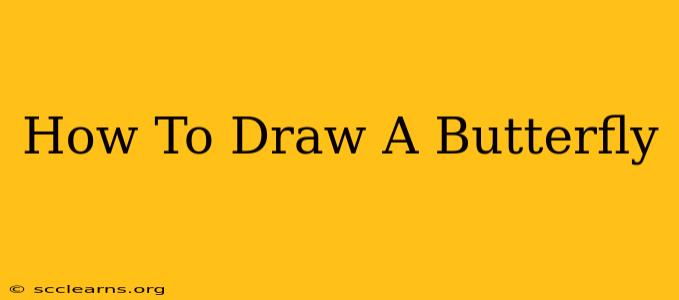Butterflies, with their vibrant wings and graceful flight, are a favorite subject for artists of all skill levels. Whether you're a complete beginner picking up a pencil for the first time or looking to refine your drawing techniques, this guide will walk you through how to draw a butterfly, step-by-step. We'll cover everything from basic shapes to adding intricate details, ensuring you create a beautiful and realistic butterfly drawing.
Getting Started: Materials You'll Need
Before we begin our artistic journey, let's gather our supplies. You won't need anything fancy; a simple setup is perfect for this project:
- Pencil: A standard HB pencil is ideal for sketching. You might also want a softer pencil (like a 2B or 4B) for shading later.
- Eraser: A quality eraser is crucial for correcting mistakes and refining your lines.
- Paper: Use drawing paper; thicker paper is better for preventing smudging and allowing for layering.
- Optional: Colored Pencils, Markers, or Paints: To add color and vibrancy to your butterfly drawing once you've finished the initial sketch.
Step-by-Step Guide: Drawing a Butterfly
Step 1: Sketching the Body
Start with the butterfly's body. Draw a long, thin oval shape for the thorax (the middle section). Then, add a smaller, slightly rounded oval at the top for the head. Connect these two ovals with a thin line.
Step 2: Creating the Wings
Next, let's create the wings. Draw two pairs of wings, one larger pair (the forewings) and one smaller pair (the hindwings). For simplicity, start by sketching them as slightly elongated teardrop shapes. The forewings should be slightly angled away from the body, while the hindwings should be positioned slightly behind the forewings. Don't worry about making them perfectly symmetrical at this stage.
Step 3: Adding Wing Details (Symmetry and Shapes)
This is where the fun begins! Let's add some detail to those wings. Look at pictures of butterflies for inspiration. You can create a variety of wing shapes and patterns. Consider these options:
- Basic Shapes: Use simple geometric shapes like circles, ovals, and triangles to build patterns within the wings.
- Symmetry: Remember that butterfly wings are generally symmetrical; try your best to make both wings mirror each other. It's okay if they aren't perfectly symmetrical – that adds to the charm!
- Experiment: Don't be afraid to get creative and experiment with different shapes and designs.
Step 4: Refining the Lines and Adding Details
Once you're happy with the overall shape and patterns, use your eraser to refine your lines, making them cleaner and smoother. Add details like veins on the wings, antennae on the head, and tiny legs beneath the body. You can add subtle curves to your lines to make the butterfly appear more lifelike.
Step 5: Shading and Adding Color (Optional)
To add depth and realism to your butterfly, carefully add shading. Use your softer pencil to create shadows on the underside of the wings and body. Blend the shading lightly for a smooth effect.
If you're using colored pencils, markers, or paints, now's the time to add color! Butterflies come in a vast array of colors and patterns, so let your creativity guide you.
Tips for Drawing Realistic Butterflies
- Study Real Butterflies: Look at photographs and illustrations of various butterfly species for inspiration. Pay attention to wing shapes, patterns, and colors.
- Practice Makes Perfect: The more you practice, the better you'll become at drawing butterflies. Don't be discouraged if your first attempts aren't perfect.
- Light Source: Consider the direction of the light source when shading your drawing. This will help create depth and realism.
- Experiment with different techniques: Try different pencil techniques, such as hatching and cross-hatching, to create texture and shading.
Beyond the Basics: Exploring Different Butterfly Species
Once you’ve mastered the basics, challenge yourself by drawing different butterfly species. Each species has unique wing shapes and patterns, offering endless possibilities for creative expression. Research different butterfly species online and use these images as references for your drawings.
By following these steps and incorporating your own creativity, you'll be well on your way to drawing stunning butterflies. Remember, the most important thing is to have fun and enjoy the process!

